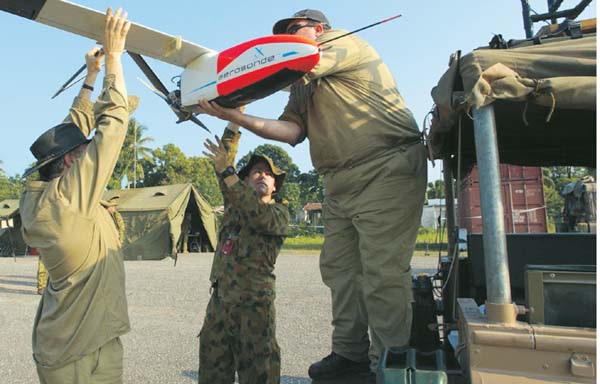Unmanned aerial vehicles (UAVs)
Introduction
In August 2003, the Australian Army deployed unmanned aerial vehicles (UAVs) as part of the Regional Assistance Mission to the Solomon Islands (RAMSI). As well as providing valuable data to the ADF, the first Australian commander of the Combined Task Force in Solomon Islands described them as “a potent psychological tool” in disrupting militia activity.
The five week trial of UAVs in Solomon Islands were the first time the ADF used pilotless aircraft in an operational environment. The results of operations in Timor and Solomon Islands were the basis of an expanded program, with the deployment to Iraq of UAVs purchased from Israel by the ADF.
Government sources
Pilotless aircraft deploy to Solomon Islands, Department of Defence media release CPA 228/03, 9 August 2003
“The Australian Defence Force will deploy four unmanned aerial vehicles (UAVs) from Townsville as part of the Regional Assistance Mission to the Solomon Islands. This is the first time the ADF will use pilotless aircraft in an operational environment. They will undertake aerial surveillance and reconnaissance missions, providing real-time information to the commander of the Coalition Task Force. The aircraft, owned by Defence and designed by Australian company Aerosonde, will deploy for five weeks.
“The aircraft will be commanded by 131 Surveillance and Target Acquisition (131 STA) Battery which has responsibility for developing Army’s UAV procedures. The deployment will also include two scientists from the Defence Science and Technology Organisation (DSTO), imagery specialists, military specialists and Aerosonde staff. The aircraft are part of the Project NERVANA developmental program. Project NERVANA, run by the Defence Science Technology Organisation, is looking at many aspects of automating the battlefield. The Solomon’s deployment will provide critical data and experience to support the ongoing development of Defence’s future UAV programs, such as Army’s Tactical UAV program and the Global Hawk system.”
Unmanned aerial vehicles deploying to Solomons, Minister for Defence Robert Hill, Media release 97/2003, 22 July 2003
“The Australian Defence Force will deploy for the first time on operations four Unmanned Aerial Vehicles (UAVs) as part of the regional assistance mission to the Solomon Islands, Defence Minister Robert Hill announced today.
‘This is the first deployment of an unmanned aerial vehicle on operations by the Australian Defence Force. It represents a significant advance in the development of our network-centric warfare capabilities.’
“Senator Hill said the Australian designed and built Aerosonde aircraft, operated by SAAB Australia, would be equipped with day and night sensors and communications equipment. They will be capable of conducting surveillance of the Solomon Islands remote areas and coastlines, providing images to military personnel on the ground and headquarters staff.”
Controllers guide UAVs, Air Force News, Vol 45 no.16, 11 September 2003.
“Uninhabited Aerial Vehicles (UAVs) are being guided in and out of Henderson Airfield in the Solomons by two air traffic controllers from No. 44 Wing as part of Operation Anode. This deployment is the first time RAAF air traffic control and UAV operations have occurred side-by-side out of an international airfield. Squadron Leader Andrew Watson, of RAAF Base Amberley, and Flight Lieutenant Darren Olsson, of RAAF Base Darwin, are supporting the four UAVs, being used for the first time in an operational environment by specialist personnel deployed as part of the UAV detachment.”
Wonderful flying machines, Cpl Sean Burton, Army – the soldiers’ newspaper, 11 September 2003
“Op ANODE has provided the first operational environment for Unmanned Aerial Vehicles (UAVs) to be deployed with the ADF. Based at Henderson Airfield near Honiara on Guadalcanal Island, the four aircraft are operated by a 15 person detachment consisting of personnel from Brisbane-based 131 STA Bty and 161 Recce Sqn. Three RAAF Image Analysts are also deployed along with two scientists from DSTO and specialists from Australian company Aerosonde, the UAV designers.
“The operational deployment will see the UAVs carry out aerial surveillance and reconnaissance missions. The aircraft are equipped with a 24-hour capability and communications equipment, which can provide real time information to assist RAMSI in re-establishing law and order.
“Major Loynes said the UAVs could be introduced full-time into the ADF by 2006-2007. The aircraft are part of the Project NERVANA developmental program, which is run by DSTO and is looking at many aspects of automating the battlefield.
“For further information on the JP129 Tactical UAV Programme go to www. Aerosonde.gov.au”
Communication as a tactic, Lieutenant Colonel John “JJ” Frewen, Defence Magazine
“…our tactical Unmanned Aerial Vehicles, or UAVs, were also a potent psychological tool that clearly played on people’s minds. We openly displayed our abilities and the imagination of the locals took over from there.”
Unmanned aerial vehicles to be deployed to Iraq, Minister for Defence Robert Hill, Media release 176/2005, 3 November 2005
“Miniature Unmanned Aerial Vehicles (UAVs) will be deployed to Iraq to provide increased protection for Australian Defence Force soldiers and will be a new ally in operational missions in the southern Al Muthanna province….The ADF has conducted extensive testing and evaluation of UAVs, including a successful operational trial of an Australian-designed UAV in the Solomon Islands in 2003.”
Analysis
The myth of the Howard government’s defence competence, James Sinnamon, Web Diary
“Additionally, in a number of smaller acquisitions, domestic Australian suppliers have been systematically discriminated against. The Government refused the Army’s request to purchase the Australian manufactured Aerosonde Unmanned Aerial Vehicle (UAV) used successfully for surveillance in the Solomons in July 2003. Instead of purchasing this proven and relatively cheap technology, the Government opened a tendering process for the supply of a more expensive high-tech version, then cut short the tendering process, instead opting only to field test two systems – both from the US.”
See also:
- UAVs: Timor-Leste
- Heron Unmanned Aerial Vehicle (UAV) detachment: Afghanistan
- Skylark UAV
- Still imagery and a low resolution MPEG video of the Skylark UAV.


